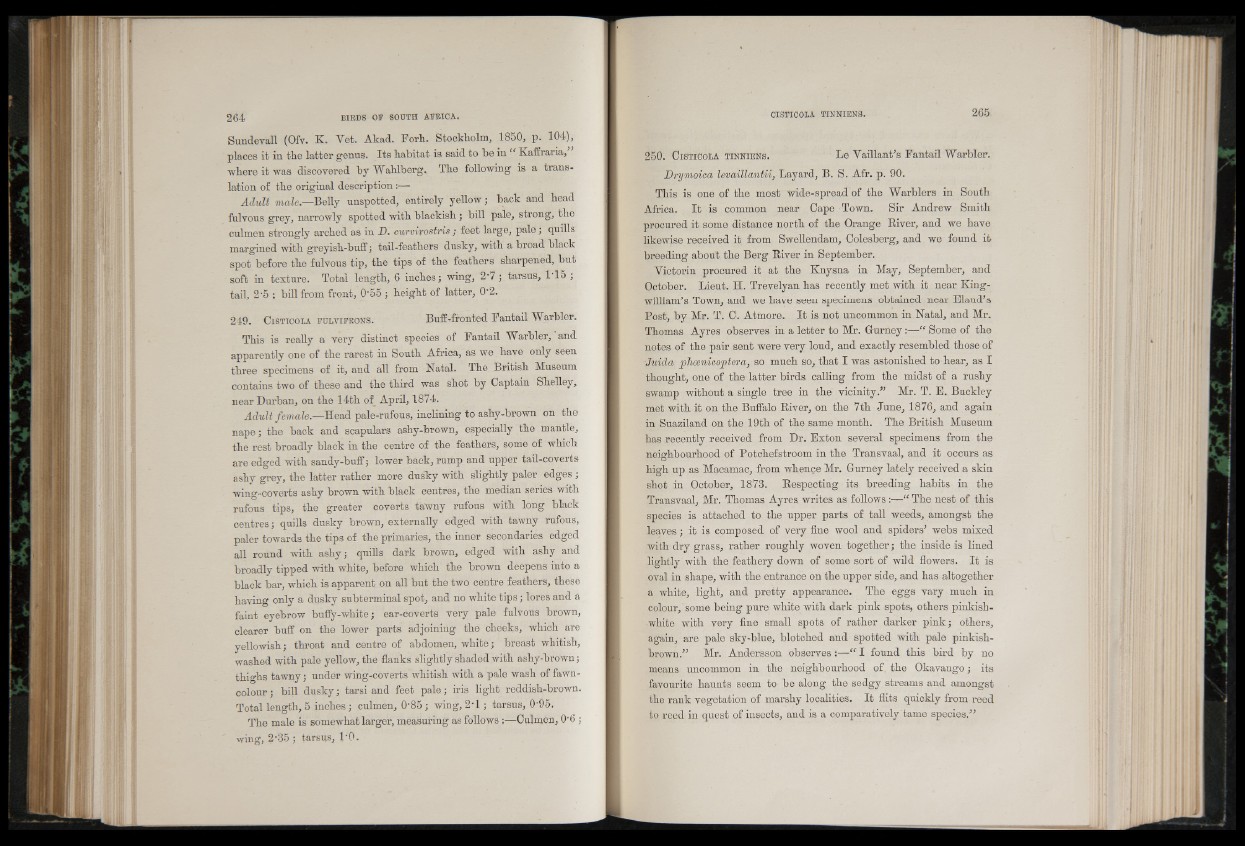
Sundevall (Ofv. K. Vet. Akad. Fork. Stockholm, 1850, p. 104),
places it in the latter genus. Its habitat is said to be in “ Kaffraria,
where it was discovered by Wahlberg. The following is a translation
of the original description:—
Adult male.—Belly unspotted, entirely yellow; back and head
fulvous grey, narrowly spotted with blackish ; bill pale, strong, the
culmen strongly arched as in D. cwrvixostris ; feet large, pale; quills
margined with greyish-buff; tail-feathers dusky, with a broad black
spot before the fulvous tip, the tips of the feathers sharpened, but
soft in texture. Total length, 6 inches; wing, 2 '7 ; tarsus, 1 15 ;
tail, 2'5 ; bill from front, 0'55 ; height of latter, 0’2.
249. C is t ic o la FUiiViFRONS. Buff-fronted Fantail Warbler.
This is really a very distinct species of Fantail Warbler, and
apparently one of the rarest in South Africa, as we have only seen
three specimens of it, and all from Natal. The British Museum
contains two of these and the third was shot by Captain Shelley,
near Durban, on the 14th of April, 1874.
Adult femaleMHead pale-rufous, inclining to ashy-brown on the
nape; the back and scapulars ashy-brown, especially the mantle,
the rest broadly black in the centre of the feathers, some of which
are edged with sandy-buff; lower back, rump and upper tail-coverts
ashy grey, the latter rather more dusky with slightly paler edges ;
wing-coverts ashy brown with black centres, the median series with
rufous tips, the greater coverts tawny rufous with long black
centres; quills dusky brown, externally edged with tawny rufous,
paler towards the tips of the primaries, the inner secondaries edged
all round with ashy; quills dark brown, edged with ashy and
broadly tipped with white, before which the brown deepens into a
black bar, which is apparent on all but the two centre feathers, these
having only a dusky subterminal spot, and no white tips; lores and a
faint eyebrow buffy-white; ear-coverts very pale fulvous brown,
clearer buff on the lower parts adjoining the cheeks, which are
yellowish; throat and centre of abdomen, white; breast whitish,
washed with pale yellow, the flanks slightly shaded with ashy-brown;
thighs tawny; under wing-coverts whitish with a pale wash of fawn-
colour ; bill dusky; tarsi and feet pale; iris light reddish-brown.
Total length, 5 inches; culmen, 085; wing, 2-1; tarsus, 095.
The male is somewhat larger, measuring as follows ;—Culmen, 0-6 ;
wing, 2-85 ; tarsus, VO.
250. C isticola t in n ie n s . Le Vaillant’s Fantail Warbler.
Drymoica leva/illantii, Layard, B. S. Afr. p. 90.
This is one of the most wide-spread of the Warblers in South
Africa. It is common near Cape Town. Sir Andrew Smith
procured it some distance north of the Orange River, and we have
likewise received it from Swellendam, Colesberg, and we found it
breeding about the Berg River in September.
Victorin procured it at the Knysna in May, September, and
October. Lieut. H. Trevelyan has recently met with it near King-
w ill Lam’s Town, and we have seen specimens obtained near Bland’s
Post, by Mr. T. C. Atmore. I t is not uncommon in Natal, and Mr.
Thomas Ayres observes in a letter to Mr. Gurney:—“ Some of the
notes of the pair sent were very loud, and exactly resembled those of
Juida phcenicoptera, so much so, that I was astonished to hear, as I
thought, one of the latter birds calling from the midst of a rushy
swamp without a single tree in the vicinity.” Mr. T. E. Buckley
met with it on the Buffalo River, on the 7th June, 1876, and again
in Suaziland on the 19th of the same month. The British Museum
has recently received from Dr. Exton several specimens from the
neighbourhood of Potchefstroom in the Transvaal, and it occurs as
high up as Macamac, from whence Mr. Gurney lately received a skin
shot in October, 1878. Respecting its breeding habits in the
Transvaal, Mr. Thomas Ayres, writes as follows:—“ The nest of this
species is attached to the upper parts of tall weeds, amongst the
leaves; it is composed of very fine wool and spiders’ webs mixed
with dry grass, rather roughly woven together; the inside is lined
lightly with the feathery down of some sort of wild flowers. It is
oval in shape, with the entrance on the upper side, and has altogether
a white, light, and pretty appearance. The eggs vary much in
colour, some being pure white with dark pink spots, others pinkish-
white with very fine small spots of rather darker pink; others,
again, are pale sky-blue, blotched and spotted with pale pinkish-
brown.” Mr. Andersson observes;—“ I found this bird by no
means uncommon in the neighbourhood of the Okavango; its
favourite haunts seem to be along the sedgy streams and amongst
the rank vegetation of marshy localities. It flits quickly from reed
to reed in quest of insects, and is a comparatively tame species.”